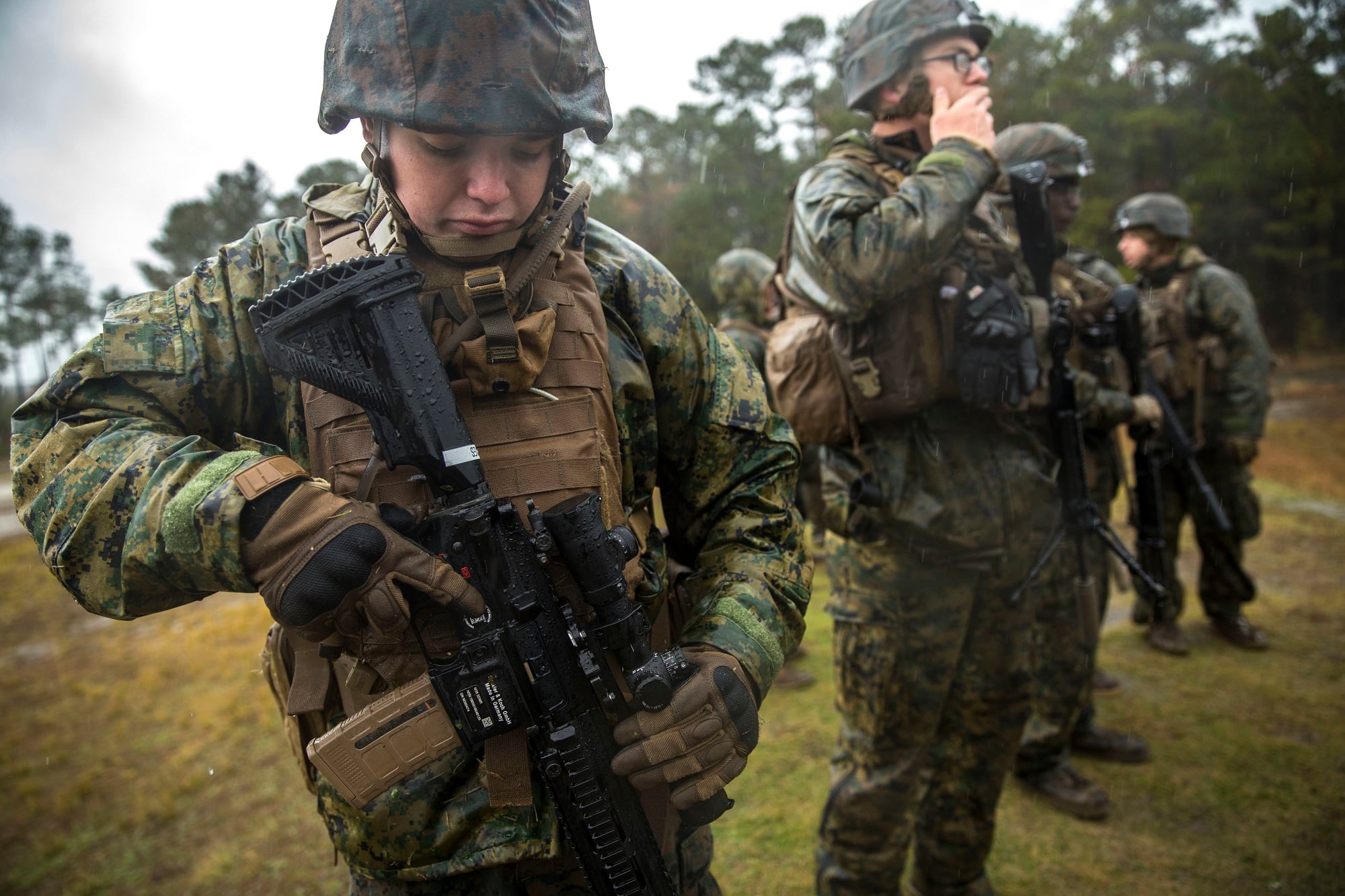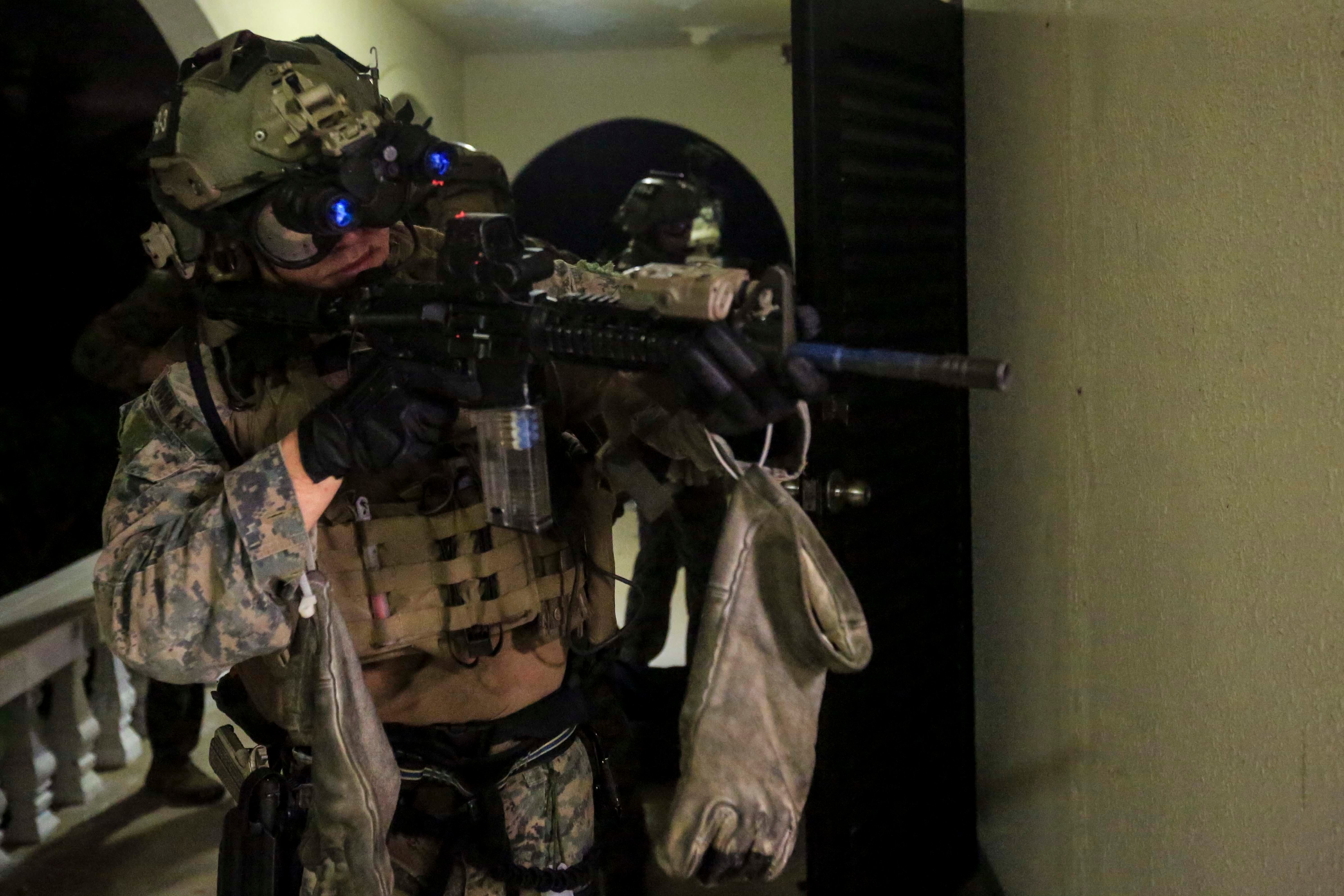The Corps is on a major push to overhaul how its fundamental basic unit operates in battle — providing grunts with modernized equipment and new roles and responsibilities.
After nearly 17 years of fighting in war-torn regions like Iraq and Afghanistan, the development comes as the lines between conventional infantry forces and America’s elite special operators have increasingly blurred.
In late December, Secretary of Defense James Mattis told reporters that conventional forces would start assuming greater roles in mission sets that were once the purview of special operations forces.
In fact, that’s already happening.
Conventional forces and special operators have been working side by side in places like Iraq and Syria. For example, in Syria, a small group of roughly 400 Marines deployed last year to back Syrian Democratic Forces fighting Islamic State militants, providing 24-hour artillery and fires support.
In Afghanistan, a small detachment of 300 Marines known as Task Force Southwest deployed last year to advise Afghan security forces in the volatile Helmand province — a mission set historically assigned to special operations forces.
And small teams of Marines are now frequently deployed to Africa for short-term missions to operate in a region that has in the past been handled by special operations troops.
To support those missions, the Corps has a new bag of goodies coming for its most fundamental Marines: the infantrymen.
The M38 and M27
The Corps is starting to designate one Marine in each infantry squad as a “marksman” and providing that Marine with an M38 rifle, the marksmanship version of the M27 Infantry Automatic Rifle.
The M38 is “the squad-designated marksman rifle which will allow Marine infantryman to engage targets at 300-600 meters,” said Barbara Hamby, a spokeswoman for Marine Corps Systems Command.
The M38 was borne out of lessons learned over the course of 17 years of fighting in places like Iraq and Afghanistan, according to Marine Gunner Chief Warrant Officer 5 Joel Schwendinger. Marines needed to be able to effectively identify and engage targets up to 600 meters.
The IAR was a good fit to transition into a designated marksman rifle because of its accuracy and long-range precision. Much of the testing and evaluation done with the IAR over the past several years carried over to the M38.
The marksman will be a new role for infantry Marines.
It will preferably be the best marksman in the squad, Schwendinger said, but it will not be a trained sniper.
There are no new certifications or specialized training for Marines to carry the M38, he said. But the designated marksman in the group will need to maintain proficiency on the M38, as outlined in the Infantry Training and Readiness Manual.
“It is the responsibility of the infantry unit commanders to train Marines assigned the M38 according to the tasks within the manual,” Schwendinger said.
To maintain that proficiency Marines will have to qualify with the M38 firing the rifle with an Mk 4 Leopold scoped optic and a night shoot with night vision and an infrared aiming device such as an AN/PEQ-15.
With the Leopold scope, Marines will have to hit eight out of 10 targets at distances from 100-600 yards, demonstrating 80 percent accuracy. With the night vision and IR lasers, Marines need to hit 12 out of 15 targets from 300 to 600 yards.
The M38 is being issued to operational forces and full operational capability is planned for the fall of 2018.

Meanwhile, the rest of the grunts in the infantry squad will soon be getting new M27 IARs to replace their M4 carbines. Every Marine in an infantry squad will soon be getting the M27, Chris Woodburn, deputy of the Maneuver Branch, Fires and Maneuver Integration at Marine Corps Combat Development Command, told Marine Corps Times in August.
The IAR was considered to be a potential replacement to the M-249 Squad Automatic Weapon, but its accuracy and long-range precision made it a potential candidate to replace the M4. The weapon is lighter than the SAW, but only boasts a 30 round magazine.
But not every Marine will get the costly IAR, which packs a whopping price tag of nearly $3,000 per rifle, meaning the M4 is not going away anytime soon. Officials at Marine Corps Systems Command are still actively working on ways to improve on the M4.
Laser range finder
The Marine Corps plans to field new rifle-mounted laser range finders that will boost lethality of infantry squads by enabling squad leaders to call in air and artillery strikes.
In August, the Marines selected the Integrated Compact Ultralight Gun-mounted Rangefinder, or I-CUGR, manufactured by Safran Optics 1.
The new tech will push more responsibility down to the infantry squad and allow for much more rapid strike capabilities.
With the new device, “a squad leader with accurate range data can quickly assign the appropriate force to eliminate threats,” Chief Warrant Officer Five Mark R. Salmons, a Marine gunner, previously told Marine Corps Times.
“This is a huge time savings that results in a higher probability of first round effects on target,” Salmons said.
The range finder can pinpoint targets up to 1,500 meters.
The Corps has procured just over 300 devices, with another 1,500 on the way sometime in early 2018.
Thermal night vision
The Marines also are interested in overhauling night vision devices currently carried by grunts. As commercially available night vision technology has proliferated to enemy fighters, U.S. troops are slowly losing their edge in nighttime battlefield supremacy.
To bridge the gap, the Corps in December asked the defense industry to provide information about helmet-mounted or hand-carried devices that include both night vision and thermal capabilities.
And Marine Corps Systems Command is currently in the process of fielding the AN/PAS-29A with explosive ordnance disposal Marines. The new device is a clip-on thermal imager for night vision devices, Hamby told Marine Corps Times.
MARCORSYSCOM may field a similar device for the infantry, but will also consider a hand-held system.
New optics
The M38 and M27 will operate different optics, and the Corps is in search of a new day-powered optic.
Marines who are issued the new marksman rifle will carry the Mk 4 Leupold TS-30A2 Mark 4 2.5-8x36mm, which packs a much higher magnification than the standard 3.5- powered advanced combat optical gunsight that is currently mounted to the IAR.
And that standard IAR optic may also soon be updated for the entire infantry squad. The Corps put out a request for information back in August for a “squad common optic.” That optic will be a variable-powered day optic, Hamby told Marine Corps Times.
The Marines want a new optic that can range targets from 600 to potentially 900 meters, and weigh under 2.1 lbs., according to the Marine Corps request for information from the defense industry.
Ops-core helmets, Lighter armor
Rumors have been buzzing since July, when images from 1st Battalion, 6th Marine Regiment, 2nd Marine Division showed grunts kitted out in new tactical vests, headsets and Ops-Core helmets.
The helmets are popular with special operators because they feature a rail mount system on the side and a distinct design that can comfortably fit large noise-canceling headsets.
RELATED

But the experimental squad known as the Über Squad, led by Chief Warrant Officer 5 Christian Wade, was merely testing out future concepts and operability of new equipment for infantry Marines.
According to officials at MARCORSYSCOM there are no plans for wider disbursement of the Ops-Core helmet, which commonly is carried by Marine Raiders and other special operations forces.
For now the Corps will stick with the more standard “ECH” helmet.
“The Enhanced Combat Helmet, used by deployed Marines since 2014, is on track to becoming the standard-issue combat helmet for every Marine,” Hamby said. “Fielding is scheduled for the spring of 2018 with the vision of the ECH as the single helmet for all operating forces.”
Nevertheless, the Marines may see lighter body armor and tactical vests in the not too distant future. The Corps is still developing the Plate Carrier Generation III.
The new prototype is 23 percent lighter than what is currently fielded and “less bulky, lighter in weight, and provides a smaller overall footprint than the current plate carrier while maintaining the same soft armor coverage and protection level,” Hamby previously told Marine Corps Times.
New lighter armored plates are also in the works.
The Corps is overhauling its infantry Marines as they begin to take on new expanded roles across the globe. The rapid push to modernize means new equipment and responsibilities are coming down the pike soon.
Shawn Snow is the senior reporter for Marine Corps Times and a Marine Corps veteran.





